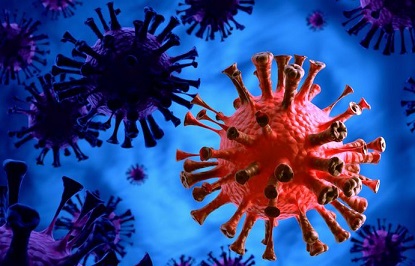Under Immune Pressure, SARS-CoV-2 Gives Rise To E484D And L1265R/H1271Y Mutations
Nikhil Prasad Fact checked by:Thailand Medical News Team May 13, 2024 1 year, 6 months, 4 days, 23 hours, 56 minutes ago
COVID-19 News: The ongoing battle against the COVID-19 pandemic has seen the emergence of various strategies, including vaccines, convalescent plasma therapy, and monoclonal antibodies (mAbs), to combat the SARS-CoV-2 virus. Among these, convalescent plasma has been a significant intervention, leveraging the immune response of recovered individuals. However, recent research has shed light on a concerning aspect of this approach - the potential for convalescent plasma to drive the evolution of SARS-CoV-2 mutations, such as the E484D and L1265R/H1271Y variants. Understanding the dynamics of these mutations is crucial for refining therapeutic strategies and developing more resilient defenses against the virus.
 Under Immune Pressure, SARS-CoV-2 Gives Rise To E484D And
Under Immune Pressure, SARS-CoV-2 Gives Rise To E484D And
L1265R/H1271Y Mutations
The Role of Spike Proteins in SARS-CoV-2 Variability
The spike (S) protein of SARS-CoV-2 plays a pivotal role in viral attachment and entry into host cells. It consists of subunits S1 and S2, with the former containing the receptor binding domain (RBD) crucial for ACE2 receptor recognition. Neutralizing antibodies generated either through infection or vaccination primarily target the S protein, conferring protection against the virus. However, this selective pressure can also drive the emergence of viral escape mutants, posing challenges to immune defenses.
Insights from Laboratory Investigations
Recent studies that are covered in this
COVID-19 News report, conducted by researchers from Changping Laboratory in Beijing, China, in collaboration with the National Institutes for Food and Drug Control (NIFDC) and other institutions, have provided valuable insights into SARS-CoV-2 evolution under immune pressure. Using replication-competent rVSV/SARS-CoV-2/GFP chimeric viruses, researchers co-incubated these viruses with sera from COVID-19 convalescents. The results revealed that mutations such as E484D and L1265R/H1271Y conferred increased viral resistance and enhanced infectivity, respectively. These findings underscore the adaptive potential of SARS-CoV-2 in response to neutralizing antibodies, highlighting the need for vigilant surveillance and targeted therapeutic interventions.
Implications for Vaccine and Antibody Therapies
As of February 18, 2024, the global impact of COVID-19 has been immense, with over 774 million cases reported by the World Health Organization. Vaccines and mAbs targeting the S protein have been instrumental in combating the pandemic. However, the emergence of mutations like E484D underscores the virus's ability to evade immune responses, necessitating the development of next-generation vaccines and antibodies targeting less mutation-prone antigenic sites. Continuous monitoring of viral mutations is crucial to stay ahead of the evolving threat posed by SARS-CoV-2.
Exploring Immune-Driven Mutational Landscapes
Laboratory experiments utilizing rVSV/SARS-CoV-2/GFP chimeric viruses exposed to convalescent sera revealed dynamic mutational landscapes. Variants su
ch as R78Q, R685Q, L1265R, H1271Y, and others showed increased prevalence under immune pressure, highlighting the diverse evolutionary paths SARS-CoV-2 can undertake. These mutations, especially E484D, significantly impacted neutralization efficacy, emphasizing the need for broader immune protection strategies.
Assessing Viral Functionality and Antigenicity
Functional assays with pseudoviruses carrying specific mutations demonstrated the impact of combinations like L1265R/H1271Y on viral infectivity. Mutations within the RBD and NTD regions, particularly E484D, influenced neutralization efficacy against convalescent and vaccinated sera. The emergence of dominant viral variants further underscored the virus's adaptive strategies under immune selection, necessitating a comprehensive approach to vaccine design and therapeutic interventions.
Monitoring Mutational Frequencies in Natural Populations
Analyzing mutations identified in laboratory studies against natural SARS-CoV-2 populations revealed low frequencies, indicating a limited current impact on circulating variants. However, the potential for these mutations to gain prevalence underscores the importance of ongoing surveillance. The evolutionary dynamics observed, akin to antiviral resistance in other pathogens, highlight the need for proactive measures in pandemic management.
Conclusion: A Call for Evolution-Informed Strategies
In conclusion, the evolution of SARS-CoV-2 under immune pressure, as exemplified by convalescent plasma-induced mutations, necessitates a nuanced approach in combating the pandemic. Insights from laboratory studies underscore the adaptive potential of the virus and the critical need for next-generation vaccines and antibodies targeting diverse antigenic sites. Continuous monitoring and evolution-informed strategies are imperative in navigating the evolving landscape of SARS-CoV-2 mutations and ensuring durable immune protection against this global threat.
The study findings were published in the peer reviewed journal: Viruses.
https://www.mdpi.com/1999-4915/16/5/763
For the latest
COVID-19 News, keep on logging to Thailand Medical News.
